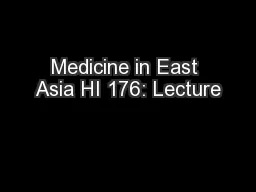

6 Dr Howard Chiang Historical Context Periodization of East Asian History China Ming 13681644 Qing 16441911 Republican 191149 PRC 1949present Japan EdoTokugawa 16031868 Japanese Empire 18681945 Showa 192689 ID: 644504
Download Presentation The PPT/PDF document "Medicine in East Asia HI 176: Lecture" is the property of its rightful owner. Permission is granted to download and print the materials on this web site for personal, non-commercial use only, and to display it on your personal computer provided you do not modify the materials and that you retain all copyright notices contained in the materials. By downloading content from our website, you accept the terms of this agreement.
Slide1
Medicine in East Asia
HI 176: Lecture 6Dr. Howard ChiangSlide2
Historical Context
Periodization of East Asian History
China: Ming (1368-1644), Qing (1644-1911), Republican (1911-49), PRC (1949-present)
Japan: Edo/Tokugawa (1603-1868), Japanese Empire (1868-1945), Showa (1926-89),
Hesei
(1989-present)
Korea:
Choson
(1392-1897), Korean Empire (1897-1910), Japanese Colony (1910-45), 2 Koreas (1945-)
Qing:
Manchu preserved basic social/political frameworks
Kaozheng
or ‘evidential scholarship’ movement
Opium War (1839-42); Taiping Rebellion (1851-64)
‘Self-Strengthening’ (1861-95); Sino-Jap War (1894-5)Slide3Slide4
First Opium WarSlide5Slide6
Fuzhou ShipyardSlide7
Partitioning of China
- Queen Victoria
- William II (Germany)
- Nicholas II (Russia)
- French Marianne
- Meiji EmperorSlide8
Medical Systems: East Asia
Until rather recently:
All healers and medical systems operated within a common set of limits: none had any route of direct access to the internal workings of the body
inferred from a narrow range of indirect evidence
Human body is a microcosm of the universe
Disease is a state of body imbalance
Chinese/East Asian Medical System:
Five ‘elements’/‘phases’ theory
(
wuyuan
) – metal (the lungs), wood (the liver), water (the kidneys), fire (the heart), and earth (the spleen)Slide9
Body as microcosm
of the universe Slide10
Medical Systems: East Asia
Chinese/East Asian Medical System:
Yin
(‘feminine’) and
Yang
(‘masculine’)
- dark/light, wet/dry, cold/warm
Does not impose a rigid duality
- within each predominantly yin or yang entity, characteristics associated with its opposite occur
Huangdi
Neijing
or the
Inner Canon of the Yellow Emperor
: the earliest surviving medical text (200BCE)
major channels known as
jing
and
mai
, through each of these channels flows a fluid substance called
qi
Healthy body depends on free circulation of
qi
-
qi
is
polysemic
: literal breath, wind in the meteorological sense, vital principle, life forceSlide11
Hua
Shou
(1341) v. Vesalius (1543)Slide12
Social, Cultural, Intellectual Trends
Qing period – fluid boundaries between multiple realms of curative and health-promoting activities
No regulations controlled who could provide healing services – the ability to attract patients was the ‘practical’ requirement to become a healer
Everyday knowledge exchange among friends, relatives, and neighbors
‘daily use encyclopedias’
‘protecting life’ (
weisheng
) and ‘nourishing life’ (
yangsheng
) – former becomes ‘hygiene’ in 20
th
c.
Internal (
neidan
) vs. external alchemy (
waidan
)
People consult & compare multiple practitioners
Everyone could be his/her own doctorSlide13
Daoist
AlchemySlide14
Gentrification of Medicine
1772: Qianlong Emperor’s
Complete Books of the Four Treasuries
(
Siku
quanshu
) – literary purge?
‘evidential research’ – to recover the original form and meaning of Han Dynasty
(206BC-220 AD) works
, which was allegedly distorted by Song-era
(960-1279) commentaries
- challenge Song-era Neo-Confucianism
- close relationship to
literate medicine
in Qing
Gentrification of medicine:
- ‘medical legitimacy’ – from ‘3 generations of medicine’ (hereditary physicians,
shiyi
) to mastery of ‘3 canonical texts’ (scholarly physicians,
ruyi
)
Qing:
qualification & authority constructed on cultural terms rather than legal regulationsSlide15
Complete Books of Four TreasuriesSlide16
Global Medical Exchange
The
materia
medica
Bencao
gangmu
(1578) by Li
Shizhen
(1518-1593) could be purchased in Korea, Japan, Vietnam, and communities in Southeast Asia
Tribute system
– structured China’s relations with other kingdoms and conduit for medical exchange
New in Qing: between China and the West
- founding the Society of Jesus in 1540
18
th
century:
- European interest in acupuncture and
moxibustion
- European interest in Chinese drugs: e.g., ginseng, ‘China root’, rhubarb, and tea
19
th
century: opiumSlide17
Li
shizhen’s
Bencao
GangmuSlide18
Acupuncture /
MoxibustionSlide19
Ginseng, Rhubarb, TeaSlide20
Western Medicine & Self-Strengthening
Treaty ports – e.g., Shanghai & Tianjin
‘cultural imperialism’ – Western medicine to E Asia
Tokugawa Japan – Dutch East India Company
17
th
& 18
th
c. China – Jesuit Missionaries
- 1693, French Dominique
Parennin
,
Manchu Anatomy
19
th
c. China – Protestant Missionaries
- British Benjamin Hobson,
Outline of Anatomy and Physiology
(1851) – first systematic translation
-
Tongwen
Guan in Beijing – translators’ school
- Scottish John Dudgeon, Gray’s
Anatomy
(1886)
- American John Kerr, Refuge for the Insane (1898)Slide21
Manchu Anatomy (1693)Slide22
Benjamin Hobson (1851)Slide23
Kerr Refuge for the InsaneSlide24
20
th
Century Transformations
In the 20
th
century, the cacophonous medical marketplace was eventually harmonized into a single medical system in which
modern biomedicine became the model against which acceptable versions of Chinese medicine were measured
1928 – Ministry of Health in China
Yu
Yunxiu
(1879-1954) led the movement to ‘abolish old-style medicine’
Chinese medicine made appear more ‘scientific’
- edited new textbooks
- founded new schools of Chinese medicine
- National Studies movement – ‘national medicine’
- embodied
experience
, what Western med. lackedSlide25
20
th
Century Transformations
Chinese medicine in the PRC (1949-present):
1949-53 – subsumed under biomedicine
1954-65 – creation of ‘traditional Chinese medicine’
1966-77 – led by ideological simplification
1976-89 – exploded into myriad options/possibilities
1989-present – integration into global health care
Globalization:
Actively supported by WHO, promoted by the Chinese state, dispersed by Chinese physicians, studied by conventional and alternative practitioners throughout the world, sought after by international clientele of patientsSlide26
Chinese medicine
- cultural imperialism?